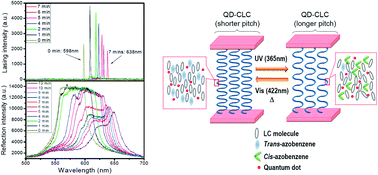An optically stable and tunable quantum dot nanocrystal-embedded cholesteric liquid crystal composite laser
Abstract
This investigation is the first report of an optically stable and tunable laser using a quantum-dot (QD) embedded cholesteric liquid crystal (QD-CLC) microresonator with an added chiral-azobenzene moiety. The QD nanocrystal, CLC, and chiral-azobenzene play key roles in the highly stable fluorescence nano-emitter, microresonator, and photo-tuner in the photonic bandgap (PBG) of the CLC and associated lasing output, respectively. Experimental results show that both the PBG and lasing emission of the QD-CLC composite sample can be reversibly tuned under successive irradiation with UV and blue beams. The all-optical tunability of the laser is attributed to the successive elongation and shrinkage of the CLC pitch induced by UV- and blue beam-irradiation induced trans–cis and cis–trans back isomerizations of chiral-azobenzene, respectively. In addition, this composite laser has a high damage threshold (>85 μJ per pulse), and thus shows a uniquely high optical stability. This work has successfully opened up an opportunity for developing QD coherent light sources or lasers with good optical stability and tunability (e.g., optically stable and tunable single photon lasers).


 Please wait while we load your content...
Please wait while we load your content...